Over the years, the Polar King sales and support teams have fielded almost any question you can imagine pertaining to walk-in freezers —and that’s no surprise when considering the numerous factors to consider when evaluating your operation’s freezing needs. What follows are answers to 12 of the walk-in freezer questions we most frequently hear:
What is a walk-in freezer vs cooler?
People often use “cooler” as a generic term when they may really mean a commercial walk-in freezer. The difference is in the construction and desired temperature. Walk-in coolers are usually set at 35°F, while walk-in freezers for most applications are set between 0°F and -10°F, with some going down to -50°F. To support these lower temperatures, walk-in freezers have thicker insulation with a higher R-value that indicates how well the insulation resists the transfer of heat. Walk-in coolers commonly use 4” insulation, while walk-in freezers use insulation that is 5”- 6” thick. Most walk-in freezers and coolers have the size and type of refrigeration to support just one temperature range, but there are also dual-temp units, which can be used as either a walk-in freezer or cooler.
How does a walk-in freezer work?
A walk-in freezer works similarly to your home refrigerator. There is an insulated space inside that heat is removed from to lower the temperature.
Here’s how it works:
- Refrigerant starts as a low-pressure, low-temperature gas and enters the compressor on the outside of the walk-in freezer.
- The compressor raises the pressure, which, in turn, increases the temperature of the refrigerant.
- The gas is now hotter than the outside environment. As it passes through the condenser coils, the excess heat radiates to the outside environment, lowering the temperature of the refrigerant.
- Next, the refrigerant passes through an expansion device that lowers its pressure, making the refrigerant even cooler as it changes state into a liquid and passes into the insulated space.
- Now the refrigerant is colder than the air inside of the unit, so it absorbs heat from the interior and starts the cycle all over again, moving the heat outside to the compressor and lowering the temperature of the interior.
- The evaporator coil will accumulate ice throughout this process, requiring a defrost heater to power on four times/day. The melted ice is sent out to the walk-in freezer’s drain pan. Newer systems may have an evaporator efficiency controller, which only defrosts when needed to reduce the amount of heat disbursed into the room.
Can a walk-in freezer be used as a cooler?
While the insulation of a walk-in freezer is more than sufficient to hold cooling temperatures, you would either need to have a dual-temperature unit that is designed to go from temperatures below freezing to refrigeration temperatures or refit your walk-in freezer with the size and type of refrigeration system that can maintain 35°F.
Click here to see the most frequently asked questions we hear about walk-in coolers.
What temperature should a walk-in freezer be?
Walk-in freezers are typically set between 0°F and -10°F, although they can go down to -50°F, depending on the application
What are best practices for walk-in freezer organization?
There will always be areas in any walk-in freezer that are warmer than others. One such place is typically near the door, where warm air rushes in each time it opens, and another is near the evaporator. Warm air will also rise to the ceiling. If you are putting particularly sensitive items in your walk-in freezer, it may be a good idea to avoid those locations. But items in freezers aren’t nearly as sensitive to slight air temperature fluctuations as they are in coolers. What really makes a difference is the temperature of the product itself. While freezing a few room temperature items in your home freezer isn’t too much of a problem, items that are placed in a walk-in freezer should ideally be within 10°F of the storage temperature.
At Polar King, we custom build each of our outdoor walk-in freezers to fit your unique needs. If your application requires quickly bringing large amounts of warm product to freezing temperatures, we can advise you on the best size and type of system for your particular situation.
Click here for our full guide to walk-in freezer and cooler organization.
What are walk-in freezer safety requirements and OSHA walk-in freezer regulations?
OSHA 1910.36(d)(1) states that, “Employees must be able to open an exit route door from the inside at all times without keys, tools, or special knowledge.”
Other safety ratings for commercial walk-in freezers include the National Fire Protection Association (NFPA) for fire safety, National Sanitation Foundation (NSF) for cleanability, Underwriters Laboratories (UL) approval of electrical components, and American Association for Testing and Materials (AATM) for industry consistency and safety.
All manufacturers must meet OSHA walk-in freezer regulations. Other ratings may not be specifically required, so manufacturers choose what ratings are most important for their products.
At Polar King, we offer optional alarms that can be installed inside of our commercial walk-in freezers and coolers. Even though we feel that the exit doors will function adequately in case of emergency, having an alarm can provide employees with confidence that they might otherwise lack.
How much electricity does a walk-in cooler use?
Refrigeration systems are standard throughout the industry. What makes the difference in energy efficiency is how well the insulation keeps the heat from entering the cold area. Polar King’s 100% seamless fiberglass design with polyisocyanurate rigid board insulation makes it by far the most energy-efficient commercial walk-in freezer on the market.
| Energy usage comparison using 8×14 unit | ||
| Polar King | Metal Panel Walk-in | |
| Annual energy consumption | 6,049kw | 16,085kw |
| Annual energy cost | $629 | $1673 |
| Annual difference | $1044 savings | $1044 loss |
*Energy test was conducted on two units, each measuring 8’x14’ and 10+ years old. Watt-hour meters were installed and monitored over a three-week period on units that were in identical climates and in similar locations.
How many amps does a walk-in freezer use?
Polar King commercial walk-in freezers have a nominal voltage of 230, single phase – 60 HZ or 208-230 volts, three phase – 60 HZ. Amperage depends on different factors, such as what model of condensing unit and evaporator you have and how much horsepower they run.
How to clean a walk-in freezer floor
The best ways to clean the floor of a walk-in freezer are to either shut the freezer down and defrost before cleaning or use freezer floor cleaner, which cleans effectively in sub-zero temperatures.
Polar King outdoor walk-in freezers feature a no-slip finish, but always take care not to leave water on the floor that can create a slip and fall hazard.
How can I remove ice from a walk-in freezer?
Your defroster should take care of minor ice buildup, but if you have excessive amounts of ice, thawing your walk-in freezer is your best option.
Why do Polar King outdoor walk-in freezers look so bright and clean inside?
Unlike competing sheet metal products that create a dingy gray appearance, Polar King walk-in freezers have the Fiberglass Advantage — one-piece seamless fiberglass surfaces inside and out. The durable, easy-to-clean white fiberglass interior has a cleaner look than sheet metal and makes it easy to find what you’re looking for.
How much does a walk-in freezer cost?
There is more to this question than you might think. There are three separate expenses that you need to consider to get a true comparison: unit cost, installation cost, and operating cost. And once you add these costs together, you can then divide them by the useful life of your commercial walk-in freezer to get an accurate cost per year.
The typical landed cost of a walk-in freezer is $15,000-$25,000, depending on the size and options that you selected. This includes the additional labor and materials the contractor you hire will need to provide to get your walk-in freezer up and running. This includes plumbing, electrical setup, assembly, starting refrigerant, and more, adding time to complete the installation as well as an additional $2,500-$4,000 to the total cost.
Polar King commercial walk-in freezers arrive fully assembled on a flatbed truck with a crane, driven by a highly skilled Polar King employee — not a subcontractor. These pre-built units can be up and running in 4-5 hours after delivery. As the most efficient walk-in freezer on the market, Polar King units cost less to operate year after year. And because better insulation means less wear on the motor, they tend to last years longer than panel boxes.
Still king of the ice
At Polar King, we’ve been providing premium outdoor walk-in freezers at the industry’s lowest lifetime cost of ownership for over 40 years. All of our walk-in freezers are custom built to your needs with Polar King’s unique Fiberglass Advantage — one-piece seamless fiberglass surfaces inside and out for the ultimate in hygienic durability. We’re so confident in our walk-in freezers that we back them with an unbeatable standard 5-year warranty on compressors and a 12-year warranty on the structure. Contact us today to find out how a Polar King walk-in freezer can make a difference in your operation.





